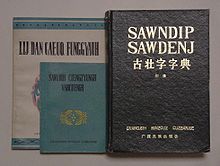
Standard Zhuang
Encyclopedia

Exonym and endonym
In ethnolinguistics, an endonym or autonym is a local name for a geographical feature, and an exonym or xenonym is a foreign language name for it...
: ; ) is the variety of Zhuang spoken in Wuming County
Wuming County
Wuming County is a county under the administration of Nanning city, Guangxi Zhuang Autonomous Region, People's Republic of China.The Wuming dialect is the prestige dialect of the Zhuang language....
in the Guangxi Zhuang Autonomous Region
Guangxi
Guangxi, formerly romanized Kwangsi, is a province of southern China along its border with Vietnam. In 1958, it became the Guangxi Zhuang Autonomous Region of the People's Republic of China, a region with special privileges created specifically for the Zhuang people.Guangxi's location, in...
of the People's Republic of China
People's Republic of China
China , officially the People's Republic of China , is the most populous country in the world, with over 1.3 billion citizens. Located in East Asia, the country covers approximately 9.6 million square kilometres...
, where it is an official language
Official language
An official language is a language that is given a special legal status in a particular country, state, or other jurisdiction. Typically a nation's official language will be the one used in that nation's courts, parliament and administration. However, official status can also be used to give a...
.
Classification
The Zhuang languages form several dialect clusters, which complicate classification. Zhang (1999) considers Wuming Zhuang to be part of Yongbei (邕北) Zhuang, one of the Northern Tai languagesNorthern Tai languages
The Northern Tai or Northern Zhuang languages are an established branch of the Tai languages of Southeast Asia. They include the northern Zhuang languages of China, such as Bouyei.-Languages:Ethnologue includes the following languages....
. However, Pittayaporn (2009) found that it lies outside Northern Tai, together with several varieties of the putative Yongnan (邕南) Zhuang. (Yongnan is not a coherent language, as several purported Yongnan varieties lie elsewhere in the Tai family, but Yongnan dialect proper is close to Wuming.)
Phonology
The Zhuang languages are tonal. Wuming Zhuang has six tones in open syllableSyllable
A syllable is a unit of organization for a sequence of speech sounds. For example, the word water is composed of two syllables: wa and ter. A syllable is typically made up of a syllable nucleus with optional initial and final margins .Syllables are often considered the phonological "building...
s:
| er="1" cellspacing="0" cellpadding="4" style="border-collapse: collapse;" |+ Consonant Consonant In articulatory phonetics, a consonant is a speech sound that is articulated with complete or partial closure of the vocal tract. Examples are , pronounced with the lips; , pronounced with the front of the tongue; , pronounced with the back of the tongue; , pronounced in the throat; and ,... s ! scope="col" style="background-color: #efefef;" | 1957 ! scope="col" | 1982 ! scope="col" style="background-color: #ddddff;" | IPA ! scope="col" style="background-color: #efefef;" | 1957 ! scope="col" | 1982 ! scope="col" style="background-color: #ddddff;" | IPA ! scope="col" style="background-color: #efefef;" | 1957 ! scope="col" | 1982 ! scope="col" style="background-color: #ddddff;"| IPA ! scope="col" style="background-color: #efefef;" | 1957 ! scope="col" | 1982 ! scope="col" style="background-color: #ddddff;" | IPA ! scope="col" style="background-color: #efefef;" | 1957 ! scope="col" | 1982 ! scope="col" style="background-color: #ddddff;" | IPA |- | style="background-color: #efefef;" | B b |
B b | | style="background-color: #efe>ef;" | | Mb mb | | style="background-color: #efe>ef;" | M m | M m | | style="background-color: #efe>ef;" | F f | F f | | style="background-color: #efe>ef;" | V v | V v | |- | D d | | style="background-color: #efe>ef;" | | Nd nd | | style="background-color: #efe>ef;" | N n | N n | | style="background-color: #efe>ef;" | S s | S s | | style="background-color: #efe>ef;" | L l | L l | |- | G g | | style="background-color: #efe>ef;" | Gv gv | Gv gv | | style="background-color: #ef>fef;" | Ŋ ŋ | Ng ng | | style="background-color: #efe>ef;" | H h | H h | | style="background-color: #efe>ef;" | R r | R r | |- | C c | | style="background-color: #efe>ef;" | Y y | Y y | | style="background-color: #efe>ef;" | Ny ny | Ny ny | | style="background-color: #efe>ef;" | Ŋv ŋv | Ngv ngv | |- | By by | | style="background-color: #>fefef;" | Gy gy | Gy gy | | style="background-color: #>fefef;" | My my | My my | |} | A a | | style="background-color: #ef>fef;" | E e | E e | | style="background-color: #efe>ef;" | Ə ə | AE ae | |- | I i | | style="background-color: #efe>ef;" | O o | O o | | style="background-color: #ef>fef;" | | W w | |- | U u | | style="background-color: #efe>ef;" | Ɵ ɵ | OE oe |
|+ Tones
! scope="col" | Tone
! scope="col" style="background-color: #efefef;" | 1957
! scope="col" | 1982
! scope="col" style="background-color: #ddddff;" | Tone contour
! scope="col" style="background-color: #ddddff;" | IPA
|-
! scope="row" | 1
| colspan="2" | Not indicated
|-
! scope="row" | 2
| style="background-color: #efefef;" |
|-
! scope="row" | 3
| style="background-color: #efefef;" | З з
|-
! scope="row" | 4
| style="background-color: #efefef;" | Ч ч
|-
! scope="row" | 5
| style="background-color: #efefef;" |
|-
! scope="row" | 6
| style="background-color: #efefef;" |
Example

| Latin script | ||
|---|---|---|
| 1957 | 1982 | English |
| Bouч bouч ma dəŋƨ laзƃɯn couƅ miƨ cɯyouƨ, cinƅyenƨ cəuƽ genƨli bouчbouч biŋƨdəŋз. Gyɵŋƽ vunƨ miƨ liзsiŋ cəuƽ lieŋƨsim, ɯŋdaŋ daiƅ gyɵŋƽ de lumз beiчnueŋч ityieŋƅ. | Boux boux ma daengz lajmbwn couh miz cwyouz, cinhyenz caeuq genzli bouxboux bingzdaengj. Gyoengq vunz miz lijsing caeuq liengzsim, wngdang daih gyoengq de lumj beixnuengx ityiengh. | All human beings are born free and equal in dignity and rights. They are endowed with reason and conscience and should act towards one another in a spirit of brotherhood. |
| Sawndip |
|---|

